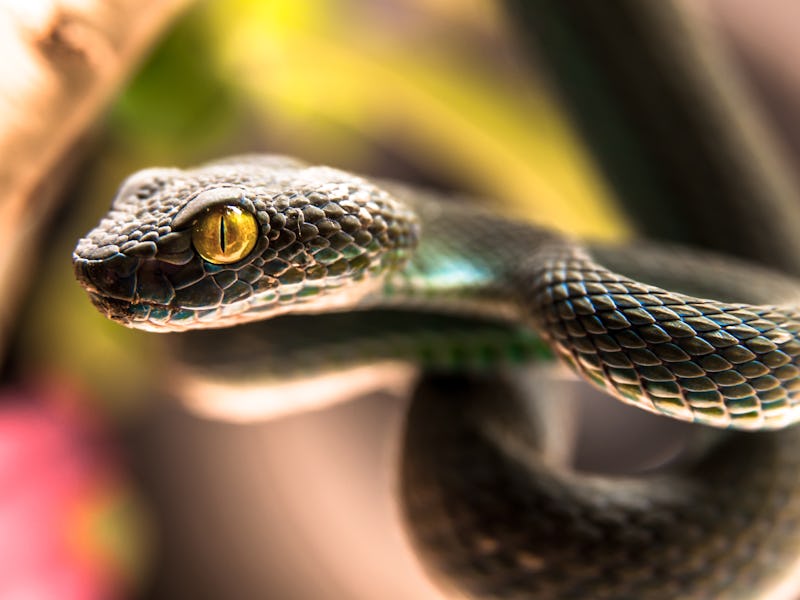How snake heat vision is being used to transform robotics
Cracking this secret snake code could be the future of efficient technology.

It's the stuff of nightmares: Stumbling through brush in the night, you hear the warning shake of a rattle snake's tail. You, blind in the dark, can't see it — but thanks to the snake's thermal vision, you know it can see you.
The power of heat vision sounds like something straight out of the Marvel Universe, but this evolutionary trait is alive and well in pit-viper snakes like rattlers and pythons. And while human technology can mimic it (infrared goggles, anyone?) scientists don't actually know how the snakes accomplish this incredible feat.
A new study published Wednesday in the journal Matter sheds some light on this mysterious snake power. In the study, a team of mathematicians and engineers attempt to recreate the way pit-vipers transform thermal heat energy into electric signals, enabling them to see in the dark. If humans can harness this power, then it could enable us to design flexible pyroelectric materials — essentially, easily manipulated materials that can generate electric charge from heat.
"Our solution is deceptively simple."
Materials that convert heat to electricity are typically found in inflexible objects, like crystals, but cracking the viper code could help scientists imbue more flexible materials with these qualities as well. Imagine: a beach umbrella that charges your phone as it shades you from the sun.
Lucky for these researchers, pit-vipers and their vision are well-studied. Previous research has enabled us to understand how these snakes "see" in the dark using something called a "pit organ" — a hollow chamber near the snake's nostrils that contains a thin, flexible membrane. But the exact mechanism driving the conversion of heat to electrical signals in the brain was still unknown, the authors write.
See also: Anti-solar panel can generate electricity at night, researchers say
This 2D illustration shows how the pit organ membrane converts heat energy into electricity.
"People thought we could explain the [infrared] sensing of snakes if there was a hard, pyroelectric material in their pit organ, but nobody ever found one," Pradeep Sharma, a lead author on the study and professor of mechanical engineering at the University of Houston, said in a statement. "So, we wondered whether just as we are trying to make these soft materials pyroelectric, maybe nature is doing the same thing."
Reverse engineering — Using the soft membrane of the viper's pit organ as inspiration, Sharma and his colleagues generated a mathematical model to explain how the organ was transforming heat information into electric signals — and in turn, how scientists could create materials that do the same thing.
"Our solution is deceptively simple," Sharma said. "[T]o make a pyroelectric soft material all you need is to embed static, stable charges into the material and ensure they don't leak out."
Combined with several other key attributes — being soft enough to change in shape and size, and being sensitive to temperature — Sharma explains it is feasible any material could act in this way.
This is exactly what the neurons in the pit organ membrane are doing, the researchers say.
"[W]e believe that's what exactly nature is using because this process is simple and robust," Sharma said.
The technique could also be used to revolutionize how soft robots are powered.
Not to be confused with their noses, vipers use their small "pit organ" to "see" heat signatures of prey.
From theory to reality — It is important to note that the research here is theoretical — and that creates some limitations on what we can glean about real-world snakes' powers.
For example, the thickness of the viper's pit organ membrane was only estimated in this study, and not exactly measured.
The next step for this research will be to study how well the membranes of real vipers match the model. Future research can also look at the role of different protein channels in the membrane, and how they might play in to its pyroelectric properties.
Sharma is optimistic that the model will bear out, however.
"Using this model, I can confidently create an artificial soft material with pyroelectric properties — of that there is no doubt," Sharma said. "We are fairly confident that we have uncovered at least part of the solution of how these snakes are able to see in the dark. Now that we've developed the model, other scientists can come forward and start doing the experiments to confirm or deny whether our theory about snake [infrared] sensing is correct."
Abstract: Pit-bearing snakes (vipers, pythons, and boas) have the extraordinary ability to ‘‘see’’ and accurately locate their prey and predators in total darkness. These animals use the infrared radiation emanating from objects that are warmer relative to the background environment to form a thermal image. Although enormous progress has been made to identify the key physiological features that enable the infrared vision of these snakes and a few other animals, the precise thermoelectric transduction mechanism that mediates the conversion of infrared heat to processable electrical signals has remained elusive. In this work, we quantitatively outline how cells in the snake’s pit membrane organ act as apparent pyroelectric materials and convert infrared radiation into electrical signals. Despite the exceptional simplicity of our proposed mechanism and model, we are able to explain many central experimental results pertaining to the transduction process.